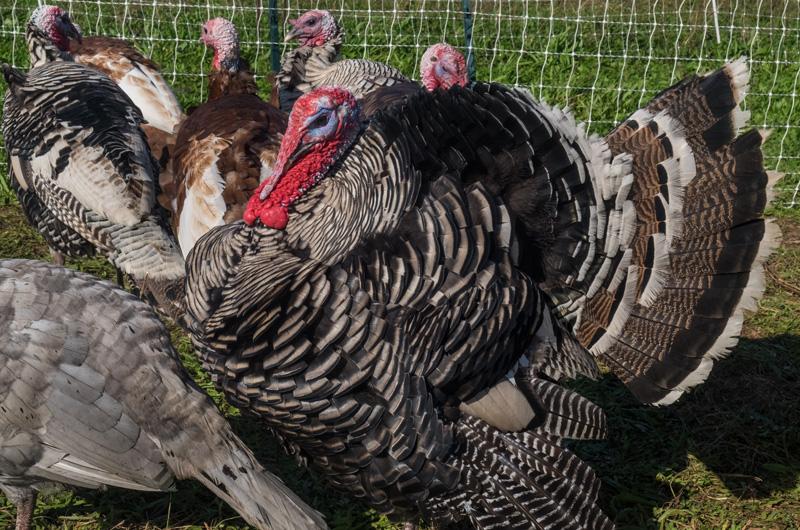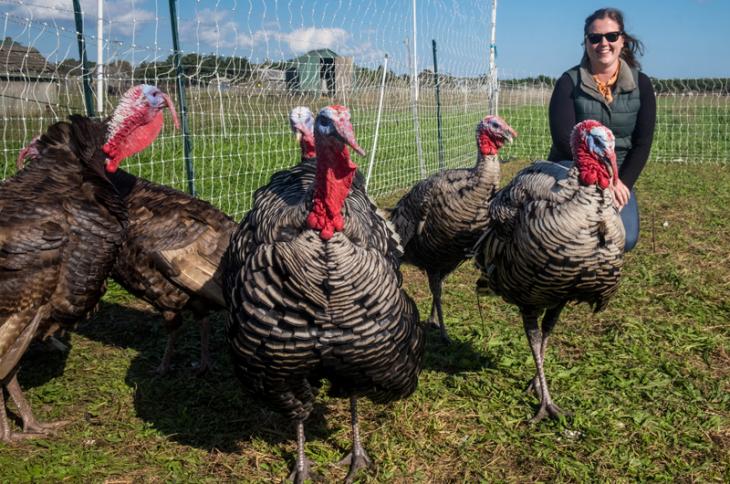Out in Katama, on a vast grassy plain that runs out of green only when it crashes into a storybook blue horizon, there is a flock of 50 or so heritage turkeys living the good life. They are free to augment their diet of non-GMO, hormone-free grain with as many bugs and worms as they like, or nosh on whatever else they scratch up in the grass as they cruise around their movable pen. At night they retire to a simple shelter with plenty of roosting spots.
If you were to visit, you might notice they have a tendency to gobble-gobble in unison, a shrill chorus not unlike the teapot boiling, over and over again. When they gobble-gobble, they also huddle-huddle, like a football team on fourth down. Supposedly only the Toms gobble and the hens cluck (I’ll just leave that right there), but one thing is for sure, they make a lot of fuss, for no apparent reason.
I can attest to this, having interviewed them this week at The Farm Institute. As a stiff breeze whipped the pages of my notebook to pieces, I attempted to keep the conversation light, staying mostly on the subject of fashion — How did the dainty Royal Palm come to sport such an exquisite black and white coat of feathers? And did the Spanish Black, the Bourbon Red, the Standard Bronze, and the Blue Slate color coordinate for the season?
As you can imagine, despite the wagging wattles, this conversation went south pretty quickly when all the Toms wanted to do was fan their newly grown tail feathers in an attempt to impress the hens.
Luckily, Farm Institute site manager Lindsay Brown was on hand to fill in the blanks. It was just as well, since the conversation shortly segued to the dinner table.

“People love the way these birds taste,” Lindsay told me. “Seventy-five percent of our heritage turkey buyers are repeat customers. We give them a survey, and what they focus on is the flavor and the fact that they’re locally raised, but not as much on the fact that they’re heritage breeds,” she laughed.
This is a bit ironic, because the reasons the birds taste so good (they have much more dark meat, with bigger thighs and smaller breasts, and tend to cook more quickly and stay juicy) is because they are heritage breeds.
By definition, a heritage breed must meet three criteria:
First, the birds must be able to mate naturally, to reproduce on their own. (The most widely raised commercial turkeys are Broad Breasted Whites, which have been bred for more breast meat. Because of shorter breast bones and shorter legs, this breed can no longer mate naturally and must be artificially inseminated).
Secondly, heritage birds must be able to thrive in an outdoor environment, maintaining their genetic ability to withstand and adapt to a variety of environmental conditions, as wild birds do. They forage for some of their food and exercise their muscles; they also maintain the ability to fly.
Lastly, heritage turkeys have a slow growth rate. According to the Livestock Conservancy: “Today’s heritage turkeys reach a marketable weight in about 28 weeks, giving the birds time to develop a strong skeletal structure and healthy organs prior to building muscle mass. This growth rate is identical to that of the commercial varieties of the first half of the 20th century.”
Slower growth rate and outdoor living make for tastier — and more expensive — birds. Birds that live longer consume more grain over their lifetimes, and free-range birds need space, unlike commercial birds, which spend their entire lives in cramped indoor pens. But fortunately, with organizations like the Livestock Conservancy and Slow Food’s Arc of Taste bringing awareness to the benefits of saving heritage breeds from extinction (including their ability to adapt to climate change), there is a market for the more expensive birds.
Lindsay told me that The Farm Institute, which has its own USDA-approved on-site poultry processing unit now, used to raise more of the heritage birds, but they cut back only so that they can harvest them all in one day — the Sunday before Thanksgiving. This way everyone gets a fresh turkey. (They process on Sunday, let the birds sit for 24 hours in the fridge, and then weigh them and assign the right-sized bird to each customer on the list. Tuesday is pick up day. Most of the birds dress out at 12 to 14 pounds.) Birds cost $8 per pound, and as of this writing, about half of this year’s have been reserved. The rest will go fairly quickly now that November has arrived. Every year the farm sets aside five to 10 birds to freeze and give to the Island Food Pantry for their Christmas meals.
Even if a heritage turkey is not in the plans for your family this year, you might enjoy a ride out to Katama to take a look at these handsome creatures.
And you have two more options for locally raised or sourced turkeys (as long as you order soon!).
The GOOD Farm and Cleveland Farm have teamed up again to raise 200 turkeys on-Island. These are Broad Breasted Whites, but unlike traditional commercial birds, they are pastured and have access to forage. Orders (for a variety of sizes at different price points) can be placed now by visiting thegood.farm and clicking on “order thanksgiving turkeys now!”
Morning Glory Farm is accepting orders for fresh, naturally raised (no hormones) turkeys from Outpost Farm in Holliston. ($3.95 per pound; 12- to 24-pound birds) as well as a limited number of organically raised birds from Mary’s Free Range Turkeys ($6.95 per pound) in California. They also have turkey breasts ($5.95 per pound).







